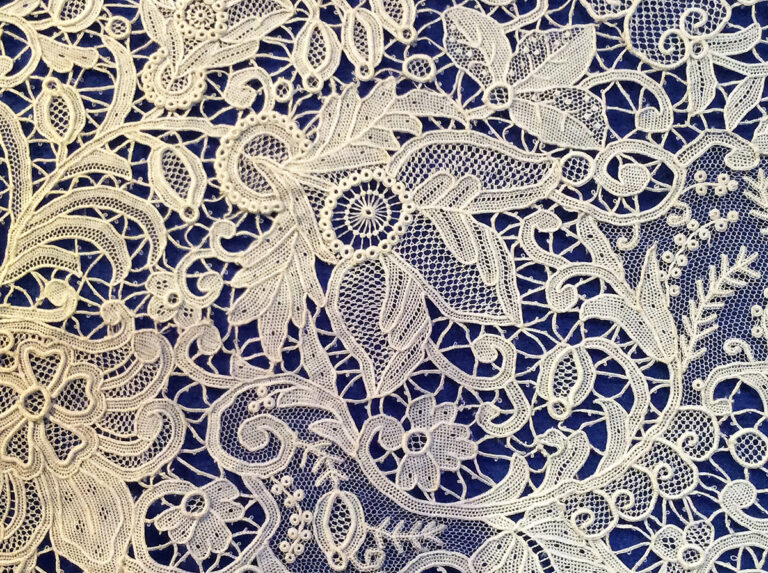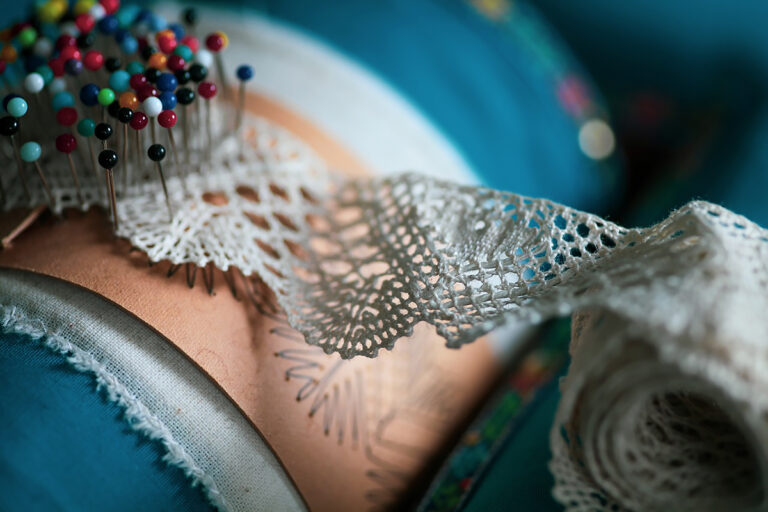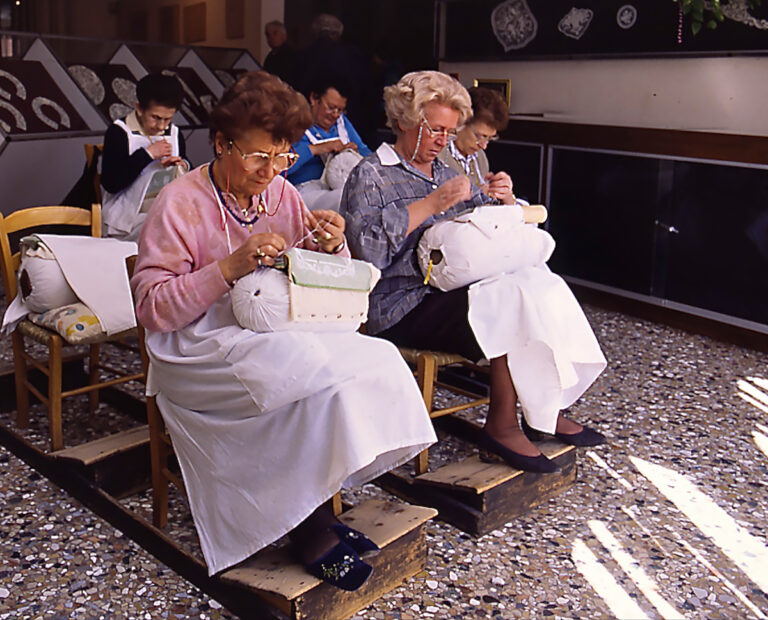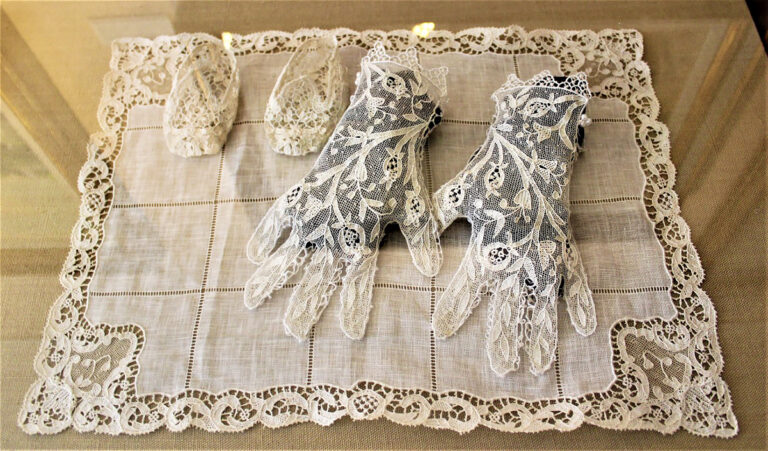The Lace of Burano,
sublime beauty!

The lace, with its intricate weave of intertwined threads, embodies a sublime expression of beauty and artisanal precision.
Each interlacing strand represents a story, a skill passed down through generations, a symbolism steeped in profound meanings.
These finely crafted textiles, with their delicacy and complexity, unveil the mastery and artistry of the hands that create them.
Laceworks are not merely works of extraordinary visual beauty, but also symbols of patience, dedication, and perfection.
Every knot, every interwoven thread is an essence of precision and commitment, encapsulating a silent language that speaks of tradition, culture, and identity.
These precious artifacts, with their timeless elegance, not only adorn spaces and objects but also transmit a legacy of savoir-faire and passion.
They symbolize an ancient art that continues to enchant and connect people through time, forging a link between the past and the present, celebrating the timeless beauty of human craftsmanship.
The Lace Museum
in Burano, Venice

Occupying the spaces of the renowned School of Lace in Burano, the museum, inaugurated in 1981, draws its origins from a rich tradition.
Established in 1872 by Countess Andriana Marcello, the School revitalized and preserved a centuries-old artisanal practice.
Following the school’s closure, a Consortium composed of Venetian public authorities and the Andriana Marcello Foundation undertook an in-depth effort to recover and culturally valorize this art form.
The School’s historical archive was meticulously reorganized and cataloged, while the spaces were renovated to transform into a captivating exhibition area.
The Lace Museum houses over a hundred extraordinary artifacts from the School’s collection and significant examples of Venetian lace production from the 16th to the 20th century.
Incorporated into the Civic Museums of Venice in 1995, the museum not only showcases precious artifacts but also provides the opportunity to witness firsthand the skills of the lace makers, authentic guardians of this ancient craft, who are present in the morning to demonstrate the crafting techniques.
The archive, a fundamental resource for scholars, preserves historical and artistic documents such as drawings, photographs, and various iconographic evidence.
Interwoven threads of magic,
to enchant and marvel.

Lace, also known as lacework or trim, represents an extraordinary art of weaving threads to create a lightweight and intricately decorated fabric.
It is more than just the creation of a fabric; it is an intricate work of interweaving in the void, a construction without a base support.
This process requires skilled hands and the use of specific tools such as the pillow lace cushion, special cards or embroidery frames, as well as various tools like bobbins, needles, crochet hooks, and others, including the direct use of fingers, as seen in macramé.
The word “dentelles” in French is simply the translation of “lace” from Italian.
Lace has an ancient history. Initially, it was created to adorn altars and religious garments; later, it became part of linen decorations and only afterward was it employed to embellish the clothing of nobility.
Over time, these fascinating decorations gained ground in fashion, giving rise to numerous artisanal industries in various European centers.
These masterpieces of weaving and detail bear witness to human mastery and the incredible dedication of artisans in creating works that still enchant today for their timeless beauty.
The ancient tradition of Burano lace

The Burano lace is recognized as one of the most prestigious in the world, with a centuries-old tradition rooted in the island of Burano, located in the Venice lagoon, where a renowned museum is dedicated to this art form.
The history of Burano lace, shrouded in mystery and legends, traces its roots back to antiquity.
Some link this typical Burano craftsmanship to the islanders’ seafaring life, closely tied to fishing and consequently, the creation and repair of nets.
The earliest traces of Venetian lace trade date back to the late 15th century, coinciding with a surge of interest in Europe and particularly in Venice.
This interest is reflected in the publication of numerous pattern books for lace and embroidery, devised by the most famous engravers and typographers of that era.
The spread of this art received a significant boost from the Doge’s wife, Morosina Morosini, who established a workshop in Venice by the late 16th century, employing up to 130 lacemakers.
Even after her passing, the art of lace continued to be cultivated, and due to the growing demand, there was planning for the organization of production and commercialization of Venetian lace.
The Merchants’ Guild obtained exclusivity, organizing work in homes, orphanages, convents, hospices, and islands.
In the 17th century, during the peak of lace’s diffusion in Europe, it became one of the wealthiest guilds in Venice!

For your wonderful stay in Jesolo (Venice), book an apartment or a room at the Germania Suite Hotel!
www.hotelgermania.net
Ph.: +39 0421 381223
e-Mail: info@hotelgermania.net
What will you see in the Lace Museum in Burano (Venice)

Inside the Lace Museum of Burano, over two hundred unique pieces from the school’s collection are exhibited, dating back from the 16th to the 20th century. This museum carefully preserves the school’s archive along with other documents and artworks linked to the tradition of Venetian lace.
Among the exhibited pieces, notable highlights include:
A collar dating back to the third quarter of the 17th century, crafted using needle lace cutwork technique.
Two fans from the 19th century, made of mother-of-pearl and ivory, created using Burano needle lace.
A centerpiece from the late 19th century, executed using the rose point needle lace technique.
A large tablecloth from the first half of the 20th century, crafted using needle and thread employing the Venetian stitch and raised work.
Within the museum, visitors can observe lacemakers at work, and additionally, it is also possible to purchase lace directly from them, accompanied by a certificate of authenticity.
Contact your
Hotel Germania in Jesolo!
Whether it’s for inquiries or to book an apartment, or a room at Hotel Germania in Jesolo, feel free to contact us by writing or calling at +39 0421 381223.









